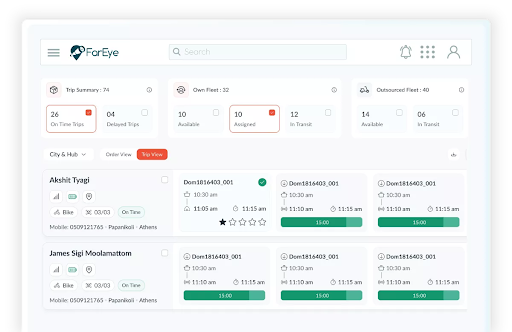- Route
How Predictive Analytics is Shaping the Future of Vehicle Routing
Table of Contents
- The Evolution of Vehicle Routing: From Traditional Schedules to Predictive Intelligence
- Understanding Predictive Analytics in Vehicle Routing
- How Predictive Vehicle Routing Software Works
- Key Features Powering FarEye’s Predictive Vehicle Routing Sofrware
- Solving the Toughest Routing Challenges with AI
- Seamless Integration and Scalable Operations
- Data Security and Governance in Predictive Vehicle Routing
- The Competitive Edge: Continuous Improvement
- Implementation Best Practices: Rolling Out Predictive Routing
- The Future is Predictive and the Time is Now
- FAQs

Modern supply chains are the backbone of our economy, yet even the most advanced logistics teams face an invisible challenge: unpredictable delays that cost millions every year. Recent research found that congestion on US highways led to $109 billion in additional operational costs for truck fleets in just one year.
This figure does not include expenses from idle time, missed service windows or inefficient dispatching. These silent costs rarely appear in annual reports but collectively impact customer satisfaction, driver morale and a company’s competitive edge.
With delivery volumes surging, e-commerce orders alone have more than doubled; efficient vehicle routing has never been more critical. Yet, many operations still rely on traditional route plans and gut-feel adjustments. In a market where every mile, minute and delivery promise counts, even small inefficiencies ripple through the entire supply chain.
The future now belongs to teams that harness predictive analytics and AI-driven vehicle routing software. These tools are transforming how dispatchers and supply chain managers address uncertainty, reduce waste and outperform the competition.

The Evolution of Vehicle Routing: From Traditional Schedules to Predictive Intelligence
Vehicle routing has come a long way from hand-drawn maps and spreadsheet-driven schedules. Legacy approaches created traditional routes that often ignored real-world variables: weather, traffic, road closures or last-minute cancellations. The rise of vehicle routing software changed the landscape, automating basic route planning and sequencing. But in fast-moving markets, only dynamic route planning driven by predictive analytics is robust enough to respond to today’s complexities.
Predictive analytics takes routing to the next level. Instead of relying on yesterday’s patterns, advanced platforms use historical data and real time inputs to forecast tomorrow’s conditions. The difference is dramatic: where once dispatchers scrambled to adapt, today’s routing programs anticipate and act before disruptions even surface.
Understanding Predictive Analytics in Vehicle Routing
At its core, predictive analytics in vehicle routing means using data to anticipate future operational conditions. These systems ingest historical delivery data, live traffic feeds, weather patterns and even macro events such as local holidays or sports games. With this information, algorithms identify trends, peak congestion zones, areas with frequent delivery failures or seasonal spikes in demand.
Machine learning models then use these patterns to forecast possible issues before they occur. For example, if a specific highway tends to back up every Friday afternoon, the routing software will automatically redirect drivers and adjust schedules for maximum efficiency. Over time, these models become increasingly accurate, fine-tuning route recommendations with every delivery completed.
How Predictive Vehicle Routing Software Works
A modern vehicle routing program is far more than a mapping tool. It is a decision-making engine that processes thousands of variables in seconds. The process starts by analyzing all active orders, driver locations, vehicle capacities, time windows and service priorities. The software then models the impact of different scenarios, unexpected delays, traffic jams or weather changes before recommending the best course of action.
What sets predictive routing apart is its dynamic, living approach. Instead of fixing routes once a day, the system updates them in real time, responding to every variable. This agility means dispatchers can adapt to disruptions on the fly and keep operations running smoothly without manual intervention.
Key Features Powering FarEye’s Predictive Vehicle Routing Sofrware
Advanced vehicle routing software delivers a competitive edge by combining predictive analytics with a suite of powerful features designed to address real-world delivery challenges.
- AI and Machine Learning
Modern vehicle routing software uses advanced AI and machine learning models to learn from every delivery event. This continuous flow of information fuels fleet optimization, ensuring every asset is used efficiently and routes are always aligned with operational goals. With every new data point, algorithms become more effective at predicting bottlenecks, driver availability and optimal load sequencing.
FarEye stands out in this space by applying machine learning to all aspects of routing, from dynamic territory planning to co-mingle loads for both FTL and LTL shipments. The platform analyzes not just historical routes but also real time operational data, providing recommendations that maximize efficiency and minimize costs. - Real Time Dynamic Routing
Gone are the days of traditional routes. With predictive analytics, vehicle routing programs now adjust plans throughout the day. If an unexpected event occurs, such as a road closure or a sudden spike in demand, the software automatically recalculates and dispatches new instructions. This reduces response time and prevents cascading delays across the network.
FarEye’s real time optimization engine dynamically allocates order sequencing stops based on traffic, delivery priorities and driver skill sets. The result is agile, resilient operations that maintain service levels even during periods of disruption. - SMART Service Times
Traditional route planning often relies on estimated service times for each stop. FarEye takes this further with its SMART Service Times feature, mapping service durations down to individual one-mile hexagons on the map.
By predicting actual dwell time at each stop based on historical patterns, the software generates predictive ETAs, leading to more reliable delivery promises and increased fleet utilization. As confidence in predictions grows, so does the overall reliability of the delivery promise. - Territory and Capacity Planning
Predictive analytics transforms how organizations allocate drivers and resources across territories. FarEye’s territory planning tools analyze up to a year of operational data, segmenting service areas by delivery density and workload.
This ensures equal workload distribution, higher driver satisfaction and better asset utilization. Automated territory adjustments mean companies can handle fluctuating demand without the chaos of daily reassignments.
Solving the Toughest Routing Challenges with AI
Predictive analytics addresses the industry’s biggest pain points. By proactively forecasting demand surges, vehicle availability and likely traffic conditions, modern vehicle routing software helps dispatchers avoid costly surprises. For example, FarEye’s AI-powered algorithms can reduce empty backhaul and idle time by orchestrating deliveries across private fleets and gig carriers based on real time rates and resource availability.
Sustainability is another key focus. More efficient routing leads to fewer miles driven, lower fuel consumption and a measurable reduction in carbon emissions. FarEye’s customers have reported up to 15% reduction in carbon footprint and up to 46% lower cost of delivery, supporting both bottom-line results and environmental targets.
Seamless Integration and Scalable Operations
Implementation of predictive analytics in vehicle routing would not necessitate a replacement of the current solutions. FarEye have plug-and-play APIs to which businesses can easily integrate their OMS, TMS or ERP and establish a smooth data flow. This integration allows the delivery of parcels, food, groceries or big and bulky items with maximum speed and flexibility of delivery.
These platforms scale exactly as a growing business does: They do not break a sweat when you throw them 10,000 orders to handle, nor when your fleet grows to 100+ vehicles. State of the art user interfaces and automation drive ease of new dispatcher and driver employee onboarding, even in complex operational environments.
Data Security and Governance in Predictive Vehicle Routing
Data privacy and security are central to modern routing solutions. Leading platforms encrypt all routing data, whether at rest or in transit and use robust access controls to protect sensitive information.
Regular audits and model explainability features ensure that algorithms are transparent, fair and compliant with industry regulations. Businesses can also monitor how models make decisions, building trust with both drivers and customers.
The Competitive Edge: Continuous Improvement
Miles apart from traditional vehicle routing, what makes predictive vehicle routing different is its learning capability. Each delivery, each exception, each feedback loop serves to improve the models on which the system relies.
This continuous improvement cycle means that organizations are not only keeping pace with market changes, but are also anticipating and exploiting them.
Enterprises powered by FarEye are transitioning from being reactive in solving consumer issues to the proactive edge of using technology to redefine their vehicle routing from a support service into a competitive advantage.
Implementation Best Practices: Rolling Out Predictive Routing
Successful adoption of predictive vehicle routing begins with a pilot phase, allowing teams to test performance on a small scale. Early stakeholder training is vital to ensure smooth adoption and user confidence.
Continuously monitor KPIs such as delivery times, fleet utilization and customer satisfaction to measure value and guide further improvements. Frequent feedback loops and system updates help the organization stay agile as business needs evolve.
The Future is Predictive and the Time is Now
No longer a nice to have for the supply chain, real-time traceability is a necessity. With delivery networks becoming more and more complicated, only those who are investing in AI-driven vehicle routing software will come out ahead. FarEye’s AI-driven vehicle routing software turns predictive insights into fewer delays, lower costs and happier customers.
The future of vehicle routing is here. And it’s data-driven, proactive and constantly getting better. The path ahead is plain for leaders who are ready to lead.
FAQs
What data sources feed predictive vehicle routing?
Predictive vehicle routing uses data from GPS, historical delivery records, live traffic, weather, customer orders and macro events like holidays. This rich mix helps generate more accurate forecasts and dynamic route plans.
How often does the software recalculate routes?
Modern predictive routing software can recalculate routes in real time, instantly responding to traffic changes, order updates or unexpected disruptions. This ensures maximum delivery efficiency throughout the day.
Can this integrate with my TMS or ERP?
Yes. Most advanced predictive vehicle routing platforms offer plug-and-play APIs that integrate smoothly with your existing TMS, ERP or OMS, enabling seamless data flow and unified operations.
Source:
https://truckingresearch.org/about-atri/atri-research/bottlenecks-congestion-infrastructure-funding/

Komal Puri is a seasoned professional in the logistics and supply chain industry. As the AVP of Marketing and a subject matter expert at FarEye, she has been instrumental in shaping the industry narrative for the past decade. Her expertise and insights have earned her numerous awards and recognition. Komal’s writings reflect her deep understanding of the industry, offering valuable insights and thought leadership.
Let's Talk to Our Experts and Optimize Your Deliveries Today!
An expert from our team will reach out within 24 hours

